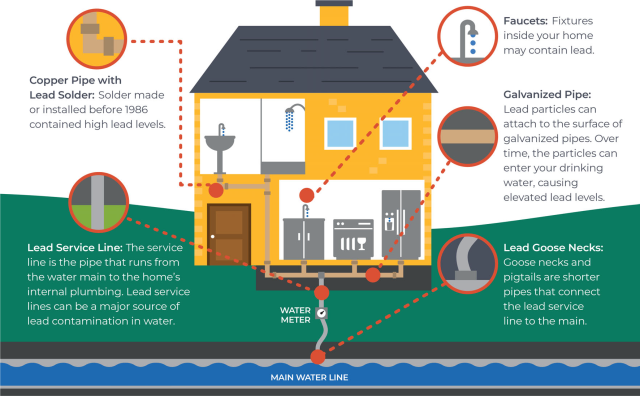EPA Researchers Share Approaches to Identify Lead Service Lines

Published March 15, 2022
Lead is one of the most challenging contaminants affecting our drinking water. Lead can enter drinking water from a variety of plumbing materials installed prior to its ban. The most common sources of lead in drinking water are old lead service lines, lead-containing faucets, other lead-containing plumbing fixtures and leaded solder joints.
A service line is the pipe that connects the water main to the plumbing in a home or building. When any part of that pipe is made of lead, it is called a lead service line.
Lead service lines were installed primarily during the late 1800s through the 1940s. Knowing the locations of lead service lines is challenging for many communities due to poor recordkeeping and long histories of repairs.
Given the public health risks, there is a need to identify lead service lines on both public and private property so that they can be removed. Water utilities are more likely to have records noting the materials that make up the service line for the portion of the line that is located under public property because it is under the water utilities’ jurisdiction. Material information on the service line portion that is under private property is often lacking. Many communities do not have good records for either portion of their service lines.
EPA researchers have identified several promising approaches that utilities can use for identifying lead service lines in their research paper, “Lead service line identification: A review of strategies and approaches” published in journal AWWA Water Science.
The first approach they identified is preliminary records review, which can help narrow down initial lead service line identification and verification efforts. Reviewing municipal and plumbing codes and construction specifications can help determine when lead service lines and lead connections, such as goosenecks, were most recently allowed. Properties that were developed before the identified end date for lead service line installation and phase out may still have lead materials.
Historical community records maintained by water utilities and municipalities can also be compiled and reviewed to help refine the list of potential lead service line locations. In addition, interviews with water distribution staff, building inspectors, and plumbers can also be valuable in uncovering information about lead service lines in a community.
Additionally, on site basic/visual examination is a way to engage residents in identifying private side service line materials. Lead is a dull, soft, non-magnetic material that turns a shiny silver color when scratched. This means a scratch test can be a simple, quick method for identifying the service line material entering a home or building. If the scratched area turns yellow orange, it is likely copper. But if it turns shiny silver, it may be lead or galvanized iron. To distinguish between lead and galvanized iron, the resident could place a magnet on the pipe. If the magnet sticks to the pipe, it’s likely iron and not lead.
Another approach includes specific water analyses which can be used to determine the lead concentration in drinking water contained within the service line, which can indicate the presence of lead. These sampling techniques include sequential, targeted, and flushed sampling. Sequential sampling (also known as profile sampling) is where researchers take multiple water samples from a household faucet, one after another, to determine potential sources of lead in the home. Targeted service line sampling is similar to sequential sampling but in this case, researchers collect the specific water liter contained within the service line if known, for example, liters 5 through 8 might be where they suspect the service line might be. And finally, flushed sampling involves turning on the water and letting it run to remove water that has been standing in the home’s interior pipes before collecting a sample from the water main. In some cases, flushed sampling may capture background water lead levels from a lead service line. Each of these approaches require resident participation or access to the property to collect the samples from a tap, usually the kitchen faucet.
Finally, excavation involves digging to visually inspect the service line underground. This is one of the most expensive ways to identify lead service lines. It involves removing soil, sidewalk, or other obstacles. However, this is one of the most accurate ways to identify service line materials.
EPA researchers are currently working with partners to refine existing approaches and identify accurate but lower-cost, alternative approaches to detect lead service lines. The Infrastructure Investment and Jobs Act aims to replace every lead pipe in the country, but the first step is for water utilities and communities to know where those pipes are located in order to replace them. EPA researchers are working with states, Tribes, and local communities to ensure they have the right tools to identify and ultimately replace these pipes.
Learn more:
Basic Information about Lead in Drinking Water
Disclaimer: The Revised Lead and Copper Rule is currently under review, and the information presented here does not necessarily reflect any requirements going forward. The purpose of this article is to share research, and EPA does not endorse one Lead Service Line identification technique over another.
